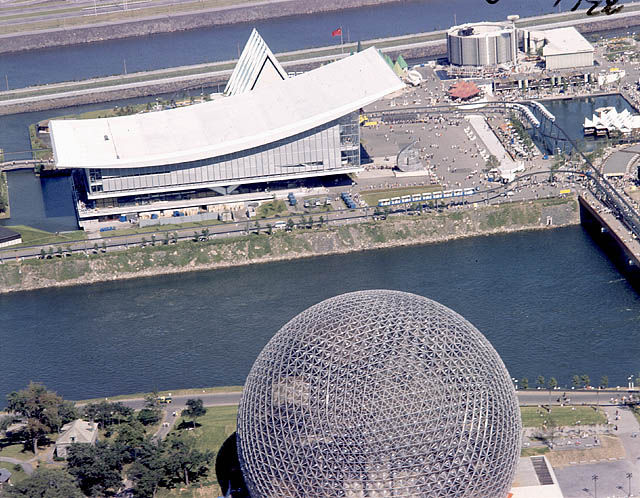
Photo credit: © National Archives of Canada From http://expo67.ncf.ca/expo_67_news_p53.html
I don’t remember the Russian pavilion. Too bad! My mom remembers there were large goldfish outside by the front entrance and some space stuff. Of course there was! I do remember getting a CCCP (USSR in Cyrillic) pin … “You will not wear that to church on Sunday” my mother to me when I had pinned my CCCP pin from EXPO to my dress on Sunday. (I think I still have that pin.)
I also don’t remember that the US pavilion was so close. More on that below. But I do remember some stuff of the US pavilion – more on that later.
Who knew that Russia had asked, and was given the right to have the world’s fair in 1967 to celebrate the 50th anniversary of the October Revolution. Canada, which had also put a bid in to celebrate, or now really, commemorate, its centennial, was denied.
EXPO PAVILIONS USSR, Canada, Biggest Attractions Copyright by the Canadian Press, October 30, 1967
The lines at the Czechoslovakian and British pavilions might have seemed the longest but it was the Soviet Union's exhibit that attracted the most visitors -- about 13,000,000.
Canada had 11,000,000 visitors, the United States 9,000,000, France 8,500,000. Czechoslovakia 8,000,000 and Great Britain 5,000,000. http://expo67.ncf.ca/expo_67_news_p53.html
The Soviet Union at the 20th-Century World's Fairs Anthony Swift
Montreal 1967 and Osaka 1970
The Soviet Union made plans to hold a world expo in Moscow in 1967 to celebrate the fiftieth anniversary of the October Revolution, but concerns about the cost and, very likely, the exposure of its citizens to bourgeois ideology and material culture led it to postpone the event indefinitely in 1962. … After the Soviet decision not to go through with the Moscow expo, Canada, which had previously made an unsuccessful bid to stage a world expo in 1967 to commemorate the centennial of its Confederation, got approval from the Bureau of International Expositions (BIE) to host Expo 67 in Montreal.
By 1967 the race to put a man on the moon was in full swing, with the outcome still in doubt, and each of the superpowers mounted large exhibits of space technology. The Soviet pavilion, fronted by a giant sculpture of a hammer and sickle, was again in a contemporary style with glass and aluminum curtain walls, but now topped by a cantilevered curved roof that contemporaries likened to a ski-jump. Designed by a team led by Mikhail Posokhin, it faced off with the acrylic geodesic dome of the United States pavilion, the work of Buckminster Fuller….
The American displays included giant pop-art paintings, cowboy gear, clips from old movies, photos of Hollywood stars, and Raggedy Ann dolls as well as the inevitable space technology, and some visitors found this depiction of American life to be frivolous and superficial. The Soviet pavilion, in contrast, was "jam-packed with all of the impressive technological displays that it can hold."68 … Inside the pavilion, visitors encountered a giant bronze sculpture of Lenin, flanked by replicas of an assortment of Soviet spacecraft and satellites. In addition to the industrial and technical exhibits that crammed the interior, consumer goods such as clothing, televisions, and automobiles were on prominent display. In Montreal the Soviets made some use of contemporary audio-visual technologies – their pavilion contained a spherical flying saucer-shaped theater in which visitors could experience the sensation of a liftoff and journey to the moon.70 They also brought a lavish program of cultural events to Montreal during the Expo that included a series of performances by the Bolshoi Opera in its second-ever visit abroad.71
From https://worldhistoryconnected.press.uillinois.edu/13.3/forum_01_swift.html
Swift, Anthony, The Soviet Union at the 20th-Century World's Fairs. World History Connected 13.3 (2016): 40 pars. 26 Apr. 2021 <https://worldhistoryconnected.press.uillinois.edu/13.3/forum_01_swift.html>.
No comments:
Post a Comment